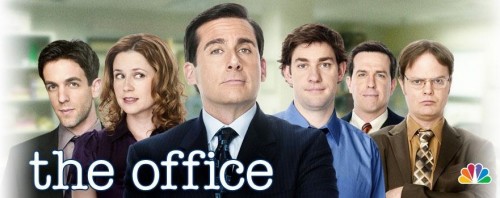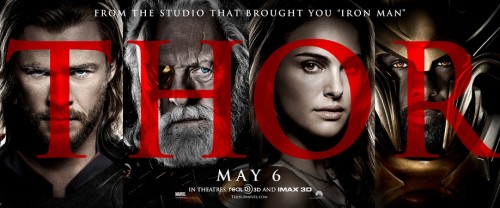Cross-posted at Jezebel.
Way back in September of last year, Baxter sent us this Star Trek promotional poster, which showed the main cast staring straight out at the viewer, with the exception of the one female character, who was turned to the side, glancing sideways at the viewer with her mouth slightly open:
We didn’t get around to posting about it at the time, but I thought of it when I saw the image from the Hulu site for the U.S. version of The Office, sent in by Jessica F. Similarly to the Star Trek poster, all of the male characters are looking straight out at the viewer, mouths closed, while the one female character has her head turned to the side, mouth slightly open; in this case, she’s looking at one of the male characters, not the viewer:
In both these posters, the men meet the viewer head-on, if you will. Their bodies are aimed straight at the viewer, they make eye contact, and that contact is confident. In contrast, the women avert themselves. Their body language is less self-assured. The woman in the Star Trek poster is alluring, a passive sexiness; the woman in the Office poster is referential, using her eyes to draw attention to the show’s star.
After initially posting those, I asked for more examples and readers sent them in. Jessica T. pointed out this banner ad for Thor:
She also found an ad for the TV show Bones, which has the women smiling at the camera much more openly (well, except for Bones):
d





Comments 64
Brian — May 24, 2011
Funny, I was thinking about this exact thing the other day when I saw the cover of Time's "100 Most Influential People" issue!
http://audreymagazine.com/wp-content/uploads/2011/04/144188_time-magazines-100-most-influential-people-2011-cover.jpg
The few women that are on there are either cut off by the edge of the magazine, looking totally away from the viewer, or (in the case of the two black women on the cover (because of course this would be what they do with the black women on the cover)) shown at a much smaller size. It was the first thing that struck me about the cover, which I wonder might be a bad sign.
Also, if I'm correct, the face under the M is the actor who plays a gay student on Glee-- he's also given the averted eyes treatment. Coincidence?
Zenbu — May 24, 2011
Also: Spock, the only non-human (afaik) - half of his face is cast in shadows.
Well, and all men have wrinkles. Uhura's face (the female) looks so polished and even...
I think this poster is a result of a copy-'n-paste accident. When looking for other posters or pictures, I always find ones where the characters look the same, but in different settings.
(Btw.: Who's the guy on the left? He's not Command, is he?)
Lynne Skysong — May 24, 2011
I know I've bashed this movie, but the New Moon and Eclipse posters have some similarities. In on they're all looking straight on at the viewer, in the other only Bella has her shoulders aimed straight at the viewers, but she's half behind Jacob and Jacob and Edward are looking at her (in a creepy possessive way if you ask me). In both posters Bella is the only one to have her mouth partially open. So it looks like (from this small collection of pics) that when a women looks at a man it's sexy/submission but when a man looks at a women is possessive/creepy.
Links for the movie posters below:
http://3.bp.blogspot.com/_okcUH2vUzQA/TAQSs8J1FKI/AAAAAAAAF7U/UbEQkE7AexA/s1600/the-twilight-saga-eclipse-movie-poster-final.jpg
http://www.comicbookmovie.com/images/users/uploads/8558/POSTERnew-moon-movie-poster.jpg
melissa — May 24, 2011
this image for the Tv Show 'The Tudors' The females do seem to look out at the viewer but their positions in the image are absolutely subordinate.
http://watchtvshow.files.wordpress.com/2010/04/the-tudors-season-4.jpg
benjamin adam — May 24, 2011
re: the office, despite a somewhat diverse cast, promotional images almost always feature only the white characters:
http://images.google.com/search?hl=en&biw=1280&bih=680&tbm=isch&sa=1&q=the+office
Merinda — May 24, 2011
The daily show banner on Hulu, the only female is looking straight at the camera.
http://assets.huluim.com/shows/key_art_the_daily_show_with_jon_stewart.jpg
Tom — May 24, 2011
The actress in the Star Trek shot is looking at the viewer. That's how it looks when you're seen in a 3/4 shot and you're looking forward to the viewer. I can understand your ignoring this, however, as it doesn't play into your flimsy and pointless thesis.
allison — May 24, 2011
I can't remember if SI has posted the posters from Men Can Stop Rape's My Strength Is Not For Hurting campaign -- I think I first saw them here, but I can't find the post again if that's the case. Here they are on the MCSR site: http://www.mencanstoprape.org/info-url2698/info-url_show.htm?doc_id=450407
I hadn't seen all the posters until a few minutes ago when I found that link, and some of the images do include a woman looking at the viewer. However, others have the woman looking at the man, or looking away. (A poster with a presumably gay couple has both men looking at the viewer.) I rather like that the men in these posters are addressing the audience, considering the message; I noticed that the women weren't looking at the camera when I first saw the posters but decided that it didn't bother me in this context.
ds — May 24, 2011
Come on, that's reaching paranoia. In the same examples it's not all men that are looking straight out, and, besides that, one could even easily interpret that the sideway look is somewhat superior.
If for some reason the same author had found examples with reversed genders, then the sideway look would be "a way to give higher status to the male, as he barely acknowledges the viewer, whereas the woman's straight out look demonstrates the submission of a lower social ranking, as someone who's instinctively obeying to a 'look straight to me when I'm talking to you, kid'".
Again, I'd like to see digital composites of different, non-discriminatory/sexist/racist designs when this sort of thing is "denounced". I bet that often we could look past in previous arguments and find examples of how the supposedly better arrangement is even worse.
Sometime ago, something was said regarding a stereotype of black woman being "manly"; not long ago, the problem was a stereotype of being curvier, more feminine. The only way to make things fair is if we only use a pasteurized multiracial asexual person for every character/person on any sort of display of a person.
Or perhaps everyone should wear burkas.
Arcadian — May 24, 2011
I've been noticing something similar on one of the TV shows I semi-regularly watch, Criminal Minds. They end their opening credits sequence with a shot of the cast looking out at the camera. The show has been on six or seven years now, and back in the beginning, they would put female characters front and center with the males, but have them facing more away from the camera: http://ant.sillydog.org/blog/pic/criminal_minds_logo_old.jpg
Over the years, the female almost-half of the cast has undergone more changes than the male (they just phased out two female characters and added only one new one, making the gender imbalance more pronounced than before) and at the same time, the women characters, though strong, interesting, and sometimes central on the show, have moved to the edges of the cast photo and turned themselves inward, looking at the men:
http://26.media.tumblr.com/tumblr_les5gecAPf1qbn3xio1_500.gif
larrycwilson — May 24, 2011
My impression of the "Office" photo is that the young lady finds the main protagonist somewhat stupid.
Matt — May 24, 2011
The two dudes on the far right are also turned away from the viewer. Their irises are not centered on their eyes, they are off to one side because their heads are slightly turned away from us.
Honestly, criticizing Star Trek for being antifeminist is seriously reaching. You're criticizing the show that put a Black woman, an Asian man and a Russian man on television in the 60s, in (non-servile) roles that never even stopped to address their cultural identity or gender as relevant.
You're criticizing the show that aired the first interracial kiss. C'mon now.
Gwen Sharp, PhD — May 24, 2011
You all are awesome! Thanks for the various examples/suggestions!
minuteye — May 24, 2011
I wonder if this tendency has anything to do with different aesthetic standards. It seems to be clear that humans consider facial symmetry to be attractive, but in fact it's very rare for a face to be perfectly symmetrical (slight differences in the size/shape of the eyes for example). A photo where the subject faces the camera emphasizes these little asymmetrical qualities, whereas a 3/4 shot hides them much more effectively.
The full-face shot gives a greater appearance of strength and confidence and really engages with the audience, so it's often a better choice for the male characters (who with their wrinkles and all, are allowed to be a little bit physically imperfect). The actresses, on the other hand, are much more likely to be there largely for titillation, and so the pose that makes their face look "prettier" is preferred.
M. Hengen — May 24, 2011
I would add that the female sideglance position also recalls the popular notion that women are devious, and while the men will approach things ‘head on’ women will obtain or achieve their will through roundabout forms, most notably seduction.
kate — May 24, 2011
my partner and i were looking through his old records yesterday and we noticed the same thing on the back of a Germ's album.
http://userserve-ak.last.fm/serve/_/12636357/The+Germs+thegerms002.jpg
MPS — May 24, 2011
Pam (the female character on The Office) might be looking at her husband Jim, not the boss Michael. Your point is not lost.
I thought perhaps with the Star Trek photo, that the off-direct glance of the female actor was to highlight her femininity, which might be more apparent from a off-direct glance than from a direct glance. (I'm referring to physical features of secondary sex characteristics, not cultural norms of posture.) However I'm not sure this argument really works with The Office photo.
Emma — May 24, 2011
Here are two more examples with Elliott from Scrubs:
http://s857.photobucket.com/albums/ab131/Singel_Mommies_Mag/Adult%20Shows/?action=view¤t=Scrubs-Cast.jpg&newest=1
http://paramoreisaband1.buzznet.com/user/photos/scrubs-cast/?id=33132661
Jess — May 24, 2011
On the other hand, this Battlestar Galactica promo photo has all the military women facing the camera head on: http://thetvaddict.com/wp-content/uploads/2009/02/bsg_pic.jpg The president is as well, but some male higher-ups are in 3/4 view.
Angie — May 25, 2011
I notice this all the time with movie posters with a solo female star in adventure type films like "Pirates of the Caribbean," "King Arthur," and "Your Highness." The female stars are always slightly angled with exaggerated cleavage rather than staring straight ahead like her male co-stars. Keira Knightley has noted it herself that the chest in promo shots isn't her own. I looked up promo shots for shows with female leads like "Parks and Recreation" and "30 Rock." The ones for "Parks and Recreation" over the past three seasons haven't had anything like that and usually the cast is either all-standing or half-sitting or half standing. No one's body is angled or trying to give the lips slightly apart look. "30 Rock" is a mixed-bag based on what seasons promos you look at. Some seasons have Jane Krakowski and Tina Fey posed more provocatively compared to their male co-stars than others. I guess since the show is going on its 6th season there's less emphasis on it incorporating the show's premise and more about having a nice photo shoot cause one of them looks like it was done for a fashion magazine rather than promoting a sitcom. "Community" started off being about its male lead Joel McHale, but has since become more ensemble based. I ran across one shot where the guys in it are acting wild or exasperated while the two young women in the show are posed leaning back with their chests out.
A — May 25, 2011
Another Office image: http://ia.media-imdb.com/images/M/MV5BMTg4NTgzNDQ1N15BMl5BanBnXkFtZTcwMDY3NTM0Mw@@._V1_SX320.jpg
CollenK — May 25, 2011
Erving Goffman addressed this type of presentation of gender in his book Gender Advertisements (1976). It has served as the base for many studies of the presentation of gender over the years (I'm using it myself in my own research). He provides 6 primary categories of gendered images: ritualization of subordination, feminine touch, function ranking, family, relative size and licensed withdrawal. The images in this post clearly demonstrate many of those. Uhuru is turned sideways with head canting-->subordination and function ranking; Pam in The Office looking away from camera, where everyone else is looking --> licensed withdrawal and function ranking.
Many of the links included in the comments also show these traits. It is important to remember that this does not mean by any stretch that ALL PHOTOS that include men and women do this. That would be very naive. What it does show us, when looking at many images, putting women in lesser/subordinate/non-threatening/less important positions is very prevalent. Some outlets show more gender stereotypes (think high end fashion) than others and in some cases these images have changed over time. But it is still the case that many, if not most, images show men in more powerful positions and women are shown with much less agency.
Am I Wearing a Dress?: Links « Kay Steiger — May 25, 2011
[...] Hey, this is weird. Women are tend to face sideways in film and television advertisements, while men tend to look straight on to the camera. [Sociological Images] [...]
Fly Free, Little Turkey Hat! « Redshirt Knitting — May 27, 2011
[...] to apologize, we don’t want to be too forward, we are enculturated to be self-deprecating. We glance away, we demur, we speak with deference. We are instructed not to rock the boat, to keep quiet unless we [...]
Race, Sex, and Casting in Hollywood Films; Tech Awards; and More « Welcome to the Doctor's Office — October 24, 2011
[...] recent trailers, casting Whites in Asian roles, Hollywood’s discomfort with Asian lead roles, gendered positioning in promotional posters, race and representation in Hollywood, the Smurfette Principle in movies, who goes to see [...]
More pairings | Polytropy — July 23, 2013
[...] Gendered Positioning in Promotional Posters [...]
Anonymous — October 27, 2018
http://lessonbucket.com/vce-media/unit-1/representation/gender-in-movie-posters/
The above website has a clear outline of how to assess gender imbalances in promotional posters